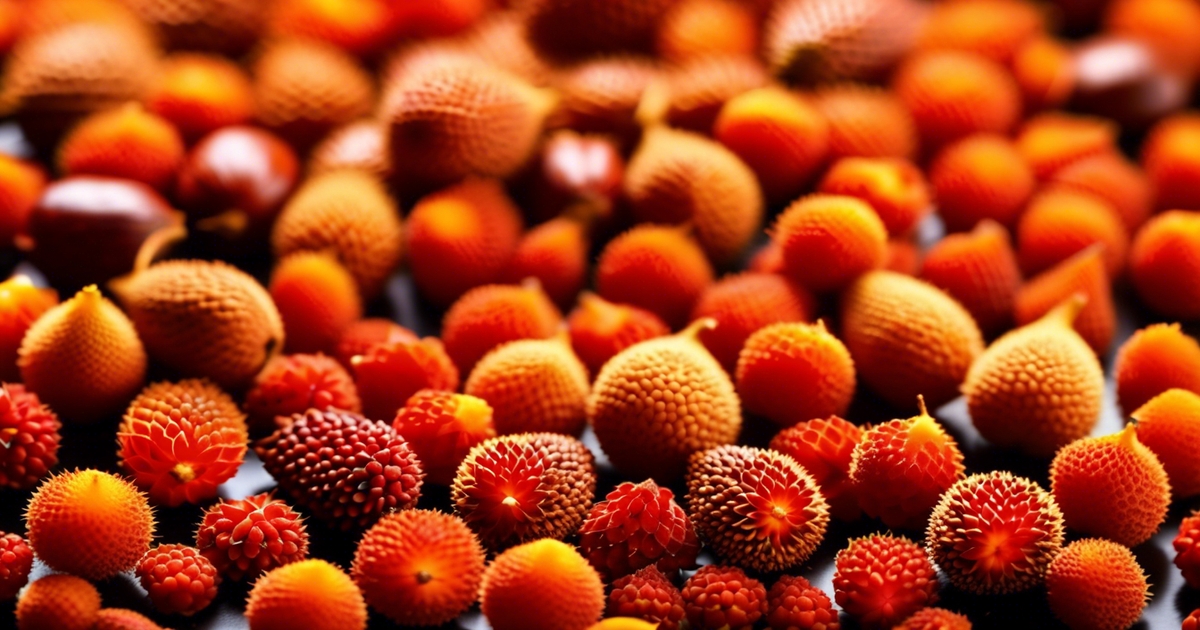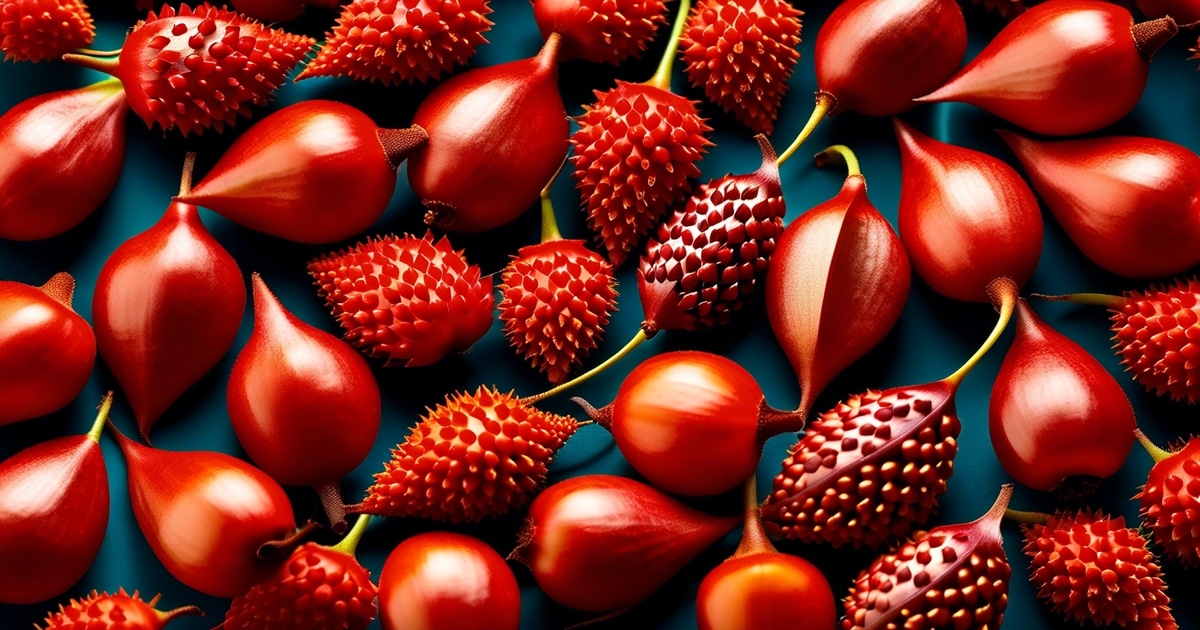Key Takeaways
- Incorporate Annatto, an important ingredient and natural food additive, in your cooking. Experiment with annatto in your recipes to add color and flavor.
- Be Mindful of Potential Allergic Reactions and Side Effects due to its natural compounds. Be cautious if you have known allergies, and consult a healthcare professional.
- Explore Traditional Medicinal Uses: Discover the historical medicinal applications of annatto, a natural food additive, and consider its potential health benefits in traditional medicine practices.
- Select High-Quality Annatto Products: When purchasing Annatto, opt for reputable sources to ensure quality and authenticity.
- Store Annatto Properly: Preserve Annatto’s freshness and potency by storing it in a cool, dry place away from direct sunlight.
- Balance Consumption for Optimal Health: While annatto offers antioxidants, consume it in moderation as part of a balanced diet for overall well-being.
- What is Annatto?
This natural food coloring and flavor enhancer comes from the seeds of the achiote tree. Widely used in Latin American and Caribbean cuisines, annatto, also known as bixin, adds a vibrant orange-red hue to dishes like rice, stews, and sauces. Beyond its culinary uses, annatto has a rich historical background as an ancient dye for textiles and body paint by indigenous tribes in tropical regions.
Annatto Origin and History
South America
Annatto, originating in South America, has a rich history dating back to ancient civilizations like the Mayans and Aztecs. These indigenous groups utilized annatto for its vibrant color as a dye for textiles and body paint.
Historical Usage
Historically, annatto was not only valued for its coloring properties but also for its culinary uses. It was commonly used to add flavor and color to various dishes, especially in Latin American and Caribbean cuisines. The seeds were also employed for their medicinal properties.
Global Journey
Over time, annatto made its way across continents through colonization and trade routes. European explorers brought it back to Europe, where it gained popularity as a natural food coloring agent. Today, annatto is widely used in the food industry globally, adding color to cheeses, butter, sauces, and even cosmetics.
Characteristics and Taste Profile
Vibrant Color
Annatto seeds are known for their vibrant red color, adding a visually appealing element to dishes. The seeds are used in various cuisines to impart a rich hue.
Flavor Profile
Subtle peppery and nutty notes define the flavor profile of annatto, enhancing the taste of dishes without overpowering other ingredients. This unique combination makes it a versatile spice.
Natural Food Coloring Agent
One of the key characteristics of annatto is its role as a natural food coloring agent. It is commonly used to add color to cheeses, rice dishes, and traditional roasted pork dishes like pibil.
Culinary Uses of Annatto

Colorful Addition
Annatto adds vibrant color to rice, stews, and sauces. Its distinct reddish-orange hue enhances the visual appeal of these culinary creations.
Cultural Significance
In traditional Latin American, Caribbean, and Filipino cuisines, annatto plays a pivotal role. It is a staple ingredient in dishes like achiote paste and is popular in Mexican cuisine for marinating meats.
Versatile Ingredient
Known for its versatility, annatto features prominently in both savory and sweet dishes. It imparts a rich color to meat marinades or rice dishes in savory recipes. It also adds a unique touch to desserts like cakes and puddings.
Health Benefits and Antioxidant Properties
Potential Benefits
Annatto, known for its antioxidant properties, offers a range of health benefits. Its high antioxidant content helps combat free radicals in the body, reducing oxidative stress and inflammation. This natural food additive is also recognized for its anticancer and antimicrobial properties, contributing to overall well-being.
Inflammation Reduction
The antioxidant-rich nature of annatto plays a crucial role in reducing inflammation within the body. Neutralizing harmful free radicals aids in preventing cellular damage and promoting healing processes.
Heart Health and Immune Support
With its essential oil components, annatto supports heart health by regulating cholesterol levels and improving cardiovascular function. Moreover, its antimicrobial activity boosts the immune system’s defenses against infections and diseases. Including annatto in foods can be a simple yet effective way to enhance overall health.
Potential Risks and Side Effects
Allergic Reactions
Annatto may trigger allergic reactions in sensitive individuals, leading to symptoms like itching, hives, or anaphylaxis. These reactions can be severe and require immediate medical attention.
Gastrointestinal Issues
In rare cases, consumption of annatto has been linked to gastrointestinal problems such as irritable bowel syndrome (IBS). Some patients reported experiencing discomfort after ingesting products containing annatto.
Importance of Moderation
Individuals must practice moderation when using products with annatto, especially if they are prone to allergies or have gastrointestinal issues. Monitoring the intake can help prevent adverse effects.
Annatto in Traditional Medicine

Historical Use
Indigenous communities have long incorporated annatto into their traditional medicine practices. Dating back centuries, the vibrant red seeds of the achiote tree were utilized for various healing purposes.
Utilized as a natural dye and flavoring agent, annatto also played a crucial role in ancient medicinal remedies due to its believed anti-inflammatory effects. The rich history of this plant showcases its versatility beyond being just a coloring agent.
Medicinal Properties
The utilization of annatto in traditional medicine is not merely rooted in folklore but supported by scientific findings. Studies suggest that annatto possesses compounds with potential anti-inflammatory and antioxidant properties, making it a valuable ingredient for therapeutic purposes.
Indigenous Healing Practices
In indigenous cultures across the globe, annatto continues to be revered for its healing properties. From treating skin conditions to aiding digestion, these communities have harnessed the power of this natural remedy for generations.
Purchasing and Storing Tips
Buying
When purchasing Annatto products, look for reputable brands known for their quality and freshness. Specialty spice stores or online retailers often offer a wide selection of products, including whole seeds and ground powder. Ensure the packaging is airtight to maintain optimal freshness.
Storing
Store your annatto in a cool, dark place away from direct sunlight and heat sources to keep it fresh. Consider transferring the seeds or powder to an airtight container to prevent moisture exposure, which can impact flavor and potency. Proper storage helps extend the shelf life of annatto.
Incorporating into Your Pantry
You may transfer some amount of annatto powder into a smaller spice jar so that this can be handy to use and stay right at arm’s length while cooking. Oil infused with annatto seeds can be made by slightly heating them in oil until they have released some color. The oil may then be used as a base for various dishes by easily adding flavor and color, which otherwise might not be present in the recipe.
Summary
You’ve learned about Annatto’s rich history, unique taste profile, culinary versatility, health benefits, and traditional medicinal uses. Understanding its origins and characteristics can enhance your cooking experience while reaping its antioxidant properties for a healthier lifestyle. Be mindful of the potential risks and consult with a healthcare provider if needed. When purchasing Annatto, follow the storing tips to maintain its quality.
Incorporate annatto into your dishes to explore its vibrant color and flavor while benefiting from its nutritional value. Experiment with this versatile ingredient to elevate your culinary creations and embrace its cultural significance. Stay informed about Annatto’s diverse applications and enjoy the journey of discovering new tastes and health benefits it can offer.
Frequently Asked Questions
What is the origin of annatto?
Annatto originates from the seeds of the achiote tree, which are native to tropical regions like Central and South America. It has been used for centuries by indigenous cultures for various purposes.
What are the culinary uses of annatto?
Annatto is commonly used as a natural food coloring agent, especially in Latin American and Caribbean cuisines. It adds a vibrant orange-red hue to rice, stews, sauces, and marinades.
What are the health benefits of annatto?
Annatto is rich in antioxidants like tocotrienols, which may help protect cells from damage caused by free radicals. It also contains anti-inflammatory compounds and potential benefits for heart health.
Are there any potential risks or side effects associated with consuming annatto?
While generally considered safe for most people when consumed in moderate amounts as a spice or food coloring, some individuals may experience allergic reactions to annatto. It’s advisable to consult with a healthcare provider if you have concerns.
How can I incorporate annatto into traditional medical practices?
Annatto has been used in traditional medicine for its purported medicinal properties, such as treating digestive issues and skin conditions. However, due to limited scientific evidence, it’s essential to consult with qualified healthcare professionals before using it for therapeutic purposes.

